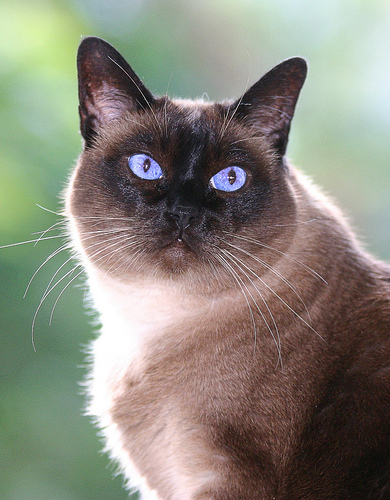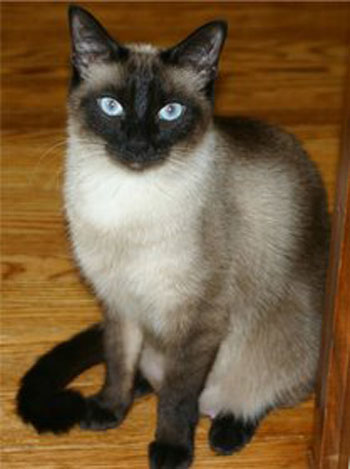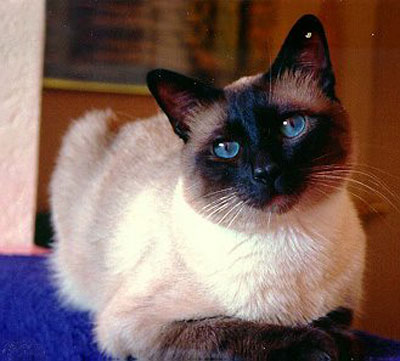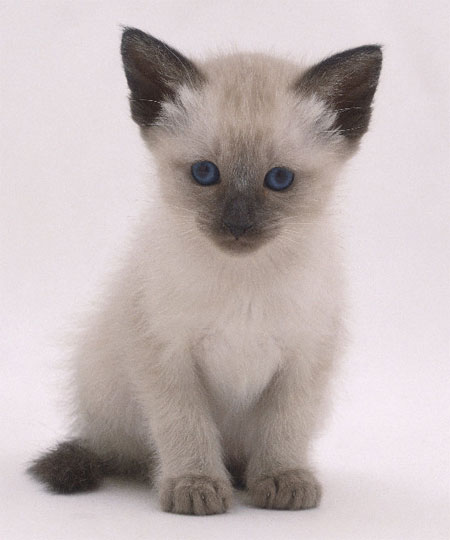



|
Characteristics and Temperament
The Traditional Siamese is an intelligent, people-oriented cat which enjoys human companionship - whether it be as a lap warmer or chasing a toy. They are inquisitive and friendly, and like nothing better than to sit in the middle of something you are trying to read. They talk to their people in an affectionate, conversational way.
With their calm temperaments, they are well-adapted to life in either a house or an apartment. They are not in perpetual motion - they have a fairly balanced activity level and are just as happy to chase a toy as to curl up in your lap for a snooze.
Frequently Asked Questions
Are Traditional Siamese friendly with other people?
Yes. They love people, and most will go right up to strangers and demand to be petted. They have the somewhat perverse nature of most cats, so are sometimes most attracted to people who either don't like cats or are allergic to them.
How are they with children?
They are good family pets, and are very indulgent of small children - they will tolerate liberties (not to be confused with ill-treatment) >from them that they will not take from adults. When they've had enough, they simply make themselves unavailable. Most of them learn to sheathe their claws when playing with people, and it is rare to be scratched.
Are they good with seniors?
With their mellow temperament they are very good with seniors - they are marvelous companions and lap cats.
How are they with other pets?
When introduced at an early age, they will usually become friends with dogs or other animals. An adult cat who is already used to dogs is a wonderful "teacher" for puppies entering the home as a pet.
How many cats should I have?
Single cats in a household do fine, though they can get lonely if left alone during the day, and will therefore demand more of your attention in the evenings. Two cats, especially if they are close in age, become good friends and are often found sleeping or playing together and grooming each other. But they still crave human attention, too.
Are they intelligent?
They are very intelligent - which does not necessarily mean that they are easy to train. Each cat has a different personality - some, if you tell them "No" once, will desist from the activity forever, while those with the more mischievous natures, though they know it's forbidden, will merely wait until you're not around, and then do it anyway. :-) Many Traditional Siamese are quite adept at teaching humans the game of fetch or other tricks. Some cats will readily learn to walk on a harness and leash. These behaviors are far more successful if introduced at an early age.
Do they scratch furniture?
Not usually - it's very easy to train them to use a scratching post, and most breeders do this. In general, they prefer a nice carpet or sisal-covered scratching post to your favorite sofa.
Are they noisy?
One of the traits a Siamese cat is known for is its voice. They can be extremely loud, and sometimes it sounds like your cat is in absolute torment, when in fact he's just trying to make a point. It's not uncommon for people on the other end of the phone to ask if there is a baby crying.
Traditionals tend to be less vocal than the modern cats - though some have the harsh "you're killing me" voice, others have a rather quiet meow. Some are non-stop talkers, while others don't talk unless they have something important to say. The voice and conversational style is apparent from kittenhood, so you'll know what you're getting into.
Do they have any bad habits?
When there are no people around, they like to be up high, and can often be found on the top of bookcases, refrigerators, or curio cabinets. If you can't find your cat, look up. It's probably best to keep any breakables off of high shelves.
Some Siamese cats engage in a practice that denizens of rec.pets.cats have dubbed "smurgling", wherein the cat holds a piece of material, usually a blanket or sweater (but sometimes human skin), in its paws and kneads it, while happily sucking and/or drooling on it. The eyes are often glazed over, and the cat is usually purring loudly. This is not a serious disorder. ( :-) for the humor-impaired.)
What are points?
Points refer to the face, ears, tail, and paws - the term is generally used in combination with color. "Seal Point" means the cat has seal colored (dark brown) points, while a "Blue Point" has blue (gray) coloring.
Will a male or a female make a better pet?
Sex of the cat makes no difference as long as they are neutered/ spayed.
Are they outdoor cats?
No, no, no, no. Almost all breeders will sell kittens with a contract stating that they be indoor-only cats, permitted outdoors only on a leash. Too many outdoor cats end up as traffic fatalities, or are severely injured by other animals. Breeders are very concerned with the welfare of the kittens they produce, and usually take great pains to insure that the kittens are going to good homes where they will be well cared for. Since most of these kittens have never been outside, they never miss it.
What health problems are they prone to?
Crossed eyes still crop up occasionally within the breed. Though undesirable, this is not a problem for the cat, and does not affect its behavior or longevity.
Kinked tails also show up occasionally, but this is merely a cosmetic fault.
Other than that, there are no known defects that are specific to the Traditional Siamese. As in most purebred animals, there are some genetic problems that creep in from time to time, but responsible breeders work very hard at keeping their lines as healthy as possible. Things to watch for in any cat, purebred or not, include umbilical hernias, heart murmurs, and kidney disease.
How big do they get?
In size, they are about what you think of when you think of an average-sized generic cat. Males weigh from 11-15 pounds, and females 8-12.
Where can I find Traditional Siamese breeders in my area?
Check the ads in the Siamese section of any cat magazine for breeders' names. Look for those advertising "Traditionals" or "Appleheads".
The Traditional and Classic Cat International (TCCI) offers a Breeder's List on their web site. This list includes many breeders who are ethical and offer healthy, purebred kittens.
How much do they cost?
They range in price from $200-$800 - registered cats from reputable breeders are more expensive.
What's the difference between Traditional Siamese and modern Siamese?
To be honest, the main difference is largely individual preference. Some people adore the new look, while others hate it.
As far as personalities go, in general, Traditional Siamese tend to be a bit more laid-back than their modern counterparts. But individuals will vary, and you will find very lively Traditionals and mellow moderns. Either type can be a delightful pet.
Why do Traditional and modern Siamese look so different?
See History.
Why don't you see Traditionals at cat shows?
The Traditional Siamese does not conform to the breed standards for Siamese cats in most of the cat associations (with the exception of the Traditional and Classic Cat International (TCCI) which wrote its standards specifically for the Traditional Siamese). As such, they are unable to compete with modern Siamese cats. Though theoretically there is nothing in the show rules that prohibits a registered cat from competing in its breed class, in practice, very few people attempt to show them as Siamese though the United Fanciers Organization (UFO) currently allows Traditional Siamese to be shown competitively under the designation "Siamese-2". In other associations they are sometimes shown in the "Household Pet" class, where breed is not a factor.
History
The Siamese is considered by many to be a "natural" breed - one that developed without the intervention of man. Pictures of seal-point Siamese cats appear in the manuscript "Cat-Book Poems", written in Siam (now Thailand) sometime between 1350 and 1700.
There are a great many legends regarding the origin of the breed - especially the crossed eyes and kinked tails. According to some of the legends, the Siamese cat guarded Buddhist temples and was considered sacred - and was only kept by priests and royalty.
The first Siamese cats appeared in the West in the mid-to-late 1800s. Though initially described as "an unnatural, nightmare kind of cat", they quickly became popular with fanciers, even though these early cats were delicate and subject to health problems. These first cats had crossed eyes and kinked tails, characteristics which are now considered faults, and have almost completely disappeared as a result of careful breeding. Photographs from the late 1880s of some of the first cats to be imported from Siam show the thick, round heads and solid, muscular bodies that distinguish the Traditional Siamese from today's show Siamese.
As the Siamese breed has developed over the years, some breeders have preferred the rounder look, while others have preferred a slender look with a wedge-shaped head. During the 1950s and 1960s, the differences became even more pronounced: show breeders developed an extremely slender cat with a very long, triangular head, almond-shaped eyes, and flaring ears. This look caught on with show-oriented Siamese breeders and with judges. Other breeders, who did not like the new look, continued to breed the larger, round-headed cats. These "Traditional" breeders found that their cats were no longer competitive in the show ring and stopped showing. A great many also stopped registering their cats, though they continued their breeding programs with their existing purebred Siamese stock.
Today, Traditional Siamese cats are somewhat rare, though they seem to be making a comeback, as the breed is popular with pet buyers.
It should be pointed out that Traditional Siamese are purebred cats, descended from the original cats imported from Siam. A pointed cat that you find in the shelter, though it may look Siamese, is probably not a Traditional Siamese cat. Enough purebred Siamese cats have interbred with domestic cats over the years that the gene which creates the pointing pattern is found in a large number of cats, and some may look Siamese when in fact they have very little Siamese blood in them.
Genetics
The "pointing" gene creates the distinct color pattern that distinguishes the Siamese breed. This gene is recessive: two pointed parents will always produce pointed kittens.
The Siamese kitten is pure white at birth - the gene that produces the "points" on the face, paws, and tail is heat sensitive, and the point color gradually develops on the cooler parts of the body. In some breeding lines, and in warmer climates, the point color may not fully develop until the cat is over a year old.
Older cats have a darker body color than young cats and kittens, though there is still a marked contrast between the body color and the point color.
The Seal Point Siamese is genetically a black cat, but the pointing gene causes the color to manifest almost exclusively on the points. As the cat matures, the creamy body color will usually give way to a light shade of the point color, particularly with seal and blue points. (For this reason, seal and blue point Siamese have relatively short careers as show cats - it's rare to see one at a cat show over the age of 2. Chocolate and lilac points don't darken as quickly and can be shown longer.)
The recognized colors are: Seal Point, Blue Point, Chocolate Point, and Lilac Point. The Red Point is not an accepted Traditional Siamese color, though it is an accepted Siamese color in some cat organizations.
Care and Training
Traditional Siamese are not delicate cats, and typically are very healthy with very good appetites. Most breeders recommend a high-quality dry food, and most cats can eat when they like without becoming overweight. Middle-aged cats (5-10) are the most likely to have weight problems, which can usually be controlled by switching to a low-calorie food.
Traditional Siamese require very little grooming on the owner's part - the cat is able to keep itself clean and well-groomed. Still, most cats enjoy the sensation of being brushed or combed, and this is a good way to remove excess fur and keep it from ending up on your clothes or your furniture. Traditional Siamese do not shed excessively.
Most Siamese cats reach sexual maturity at an early age - it is not uncommon for a female to experience her first heat at the age of 5 months. Spaying is recommended by the age of 6 months, and neutering at the age of 6 months or even earlier. If neutered at an early age, males generally do not spray.
Breeders
There aren't many Traditional Siamese breeders in the world. Each breeder tends to specialize in a different look - some have the very round, very stocky, Traditional cats, while others have a cat that TCCI calls a "Classic Siamese" which is a bit more refined, though still retaining the round head, and still others have cats that are more of a modified wedge. Prospective buyers need to decide what sort of look they prefer, and talk to breeders about their cats, their health, and their personalities.
Don't be surprised if the breeder thoroughly questions you about the sort of environment you will provide for the cat - most breeders are very careful in selecting homes for their kittens. You will probably be asked to sign an agreement stating that the cat will be spayed/ neutered, that it will NOT be declawed, and that it will be an indoor-only cat.
Many Traditional Siamese cats are not registered, even though the majority are from purebred lines whose breeders have kept meticulous records over the years. We must admit that some cats advertised as "Traditional Siamese", though they exhibit all the desirable purebred qualities, are of questionable lineage, and may have some alley cat not too far back in the pedigree. If this matters to you, you can try to find cats that are registered - though difficult, it is not impossible.
Disclaimer: The following lists have been recommended in good faith by the author. However, you are still responsible for verifying that a particular breeder meets your needs to your satisfaction.
|